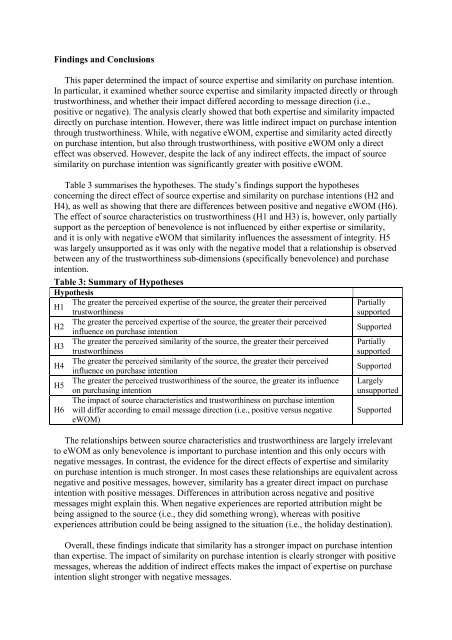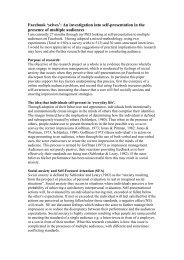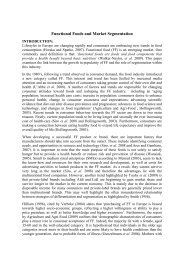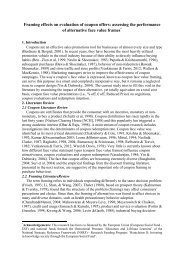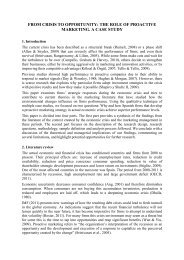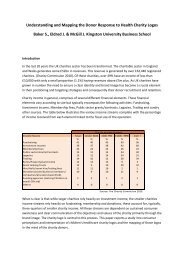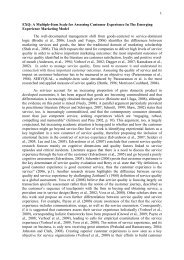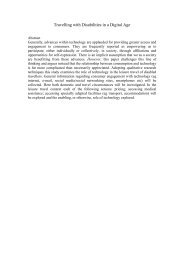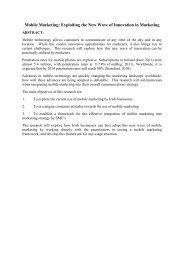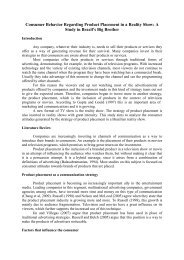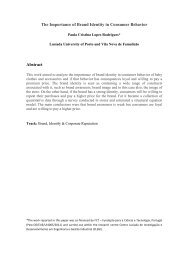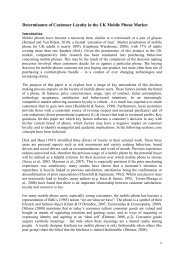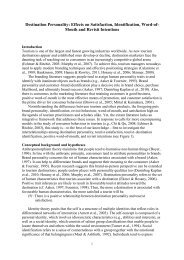The influence of positive and negative eWOM on purchase intention
The influence of positive and negative eWOM on purchase intention
The influence of positive and negative eWOM on purchase intention
Create successful ePaper yourself
Turn your PDF publications into a flip-book with our unique Google optimized e-Paper software.
Findings <str<strong>on</strong>g>and</str<strong>on</strong>g> C<strong>on</strong>clusi<strong>on</strong>s<br />
This paper determined the impact <str<strong>on</strong>g>of</str<strong>on</strong>g> source expertise <str<strong>on</strong>g>and</str<strong>on</strong>g> similarity <strong>on</strong> <strong>purchase</strong> intenti<strong>on</strong>.<br />
In particular, it examined whether source expertise <str<strong>on</strong>g>and</str<strong>on</strong>g> similarity impacted directly or through<br />
trustworthiness, <str<strong>on</strong>g>and</str<strong>on</strong>g> whether their impact differed according to message directi<strong>on</strong> (i.e.,<br />
<str<strong>on</strong>g>positive</str<strong>on</strong>g> or <str<strong>on</strong>g>negative</str<strong>on</strong>g>). <str<strong>on</strong>g>The</str<strong>on</strong>g> analysis clearly showed that both expertise <str<strong>on</strong>g>and</str<strong>on</strong>g> similarity impacted<br />
directly <strong>on</strong> <strong>purchase</strong> intenti<strong>on</strong>. However, there was little indirect impact <strong>on</strong> <strong>purchase</strong> intenti<strong>on</strong><br />
through trustworthiness. While, with <str<strong>on</strong>g>negative</str<strong>on</strong>g> <str<strong>on</strong>g>eWOM</str<strong>on</strong>g>, expertise <str<strong>on</strong>g>and</str<strong>on</strong>g> similarity acted directly<br />
<strong>on</strong> <strong>purchase</strong> intenti<strong>on</strong>, but also through trustworthiness, with <str<strong>on</strong>g>positive</str<strong>on</strong>g> <str<strong>on</strong>g>eWOM</str<strong>on</strong>g> <strong>on</strong>ly a direct<br />
effect was observed. However, despite the lack <str<strong>on</strong>g>of</str<strong>on</strong>g> any indirect effects, the impact <str<strong>on</strong>g>of</str<strong>on</strong>g> source<br />
similarity <strong>on</strong> <strong>purchase</strong> intenti<strong>on</strong> was significantly greater with <str<strong>on</strong>g>positive</str<strong>on</strong>g> <str<strong>on</strong>g>eWOM</str<strong>on</strong>g>.<br />
Table 3 summarises the hypotheses. <str<strong>on</strong>g>The</str<strong>on</strong>g> study’s findings support the hypotheses<br />
c<strong>on</strong>cerning the direct effect <str<strong>on</strong>g>of</str<strong>on</strong>g> source expertise <str<strong>on</strong>g>and</str<strong>on</strong>g> similarity <strong>on</strong> <strong>purchase</strong> intenti<strong>on</strong>s (H2 <str<strong>on</strong>g>and</str<strong>on</strong>g><br />
H4), as well as showing that there are differences between <str<strong>on</strong>g>positive</str<strong>on</strong>g> <str<strong>on</strong>g>and</str<strong>on</strong>g> <str<strong>on</strong>g>negative</str<strong>on</strong>g> <str<strong>on</strong>g>eWOM</str<strong>on</strong>g> (H6).<br />
<str<strong>on</strong>g>The</str<strong>on</strong>g> effect <str<strong>on</strong>g>of</str<strong>on</strong>g> source characteristics <strong>on</strong> trustworthiness (H1 <str<strong>on</strong>g>and</str<strong>on</strong>g> H3) is, however, <strong>on</strong>ly partially<br />
support as the percepti<strong>on</strong> <str<strong>on</strong>g>of</str<strong>on</strong>g> benevolence is not <str<strong>on</strong>g>influence</str<strong>on</strong>g>d by either expertise or similarity,<br />
<str<strong>on</strong>g>and</str<strong>on</strong>g> it is <strong>on</strong>ly with <str<strong>on</strong>g>negative</str<strong>on</strong>g> <str<strong>on</strong>g>eWOM</str<strong>on</strong>g> that similarity <str<strong>on</strong>g>influence</str<strong>on</strong>g>s the assessment <str<strong>on</strong>g>of</str<strong>on</strong>g> integrity. H5<br />
was largely unsupported as it was <strong>on</strong>ly with the <str<strong>on</strong>g>negative</str<strong>on</strong>g> model that a relati<strong>on</strong>ship is observed<br />
between any <str<strong>on</strong>g>of</str<strong>on</strong>g> the trustworthiness sub-dimensi<strong>on</strong>s (specifically benevolence) <str<strong>on</strong>g>and</str<strong>on</strong>g> <strong>purchase</strong><br />
intenti<strong>on</strong>.<br />
Table 3: Summary <str<strong>on</strong>g>of</str<strong>on</strong>g> Hypotheses<br />
Hypothesis<br />
<str<strong>on</strong>g>The</str<strong>on</strong>g> greater the perceived expertise <str<strong>on</strong>g>of</str<strong>on</strong>g> the source, the greater their perceived<br />
H1<br />
trustworthiness<br />
<str<strong>on</strong>g>The</str<strong>on</strong>g> greater the perceived expertise <str<strong>on</strong>g>of</str<strong>on</strong>g> the source, the greater their perceived<br />
H2<br />
<str<strong>on</strong>g>influence</str<strong>on</strong>g> <strong>on</strong> <strong>purchase</strong> intenti<strong>on</strong><br />
<str<strong>on</strong>g>The</str<strong>on</strong>g> greater the perceived similarity <str<strong>on</strong>g>of</str<strong>on</strong>g> the source, the greater their perceived<br />
H3<br />
trustworthiness<br />
<str<strong>on</strong>g>The</str<strong>on</strong>g> greater the perceived similarity <str<strong>on</strong>g>of</str<strong>on</strong>g> the source, the greater their perceived<br />
H4<br />
<str<strong>on</strong>g>influence</str<strong>on</strong>g> <strong>on</strong> <strong>purchase</strong> intenti<strong>on</strong><br />
<str<strong>on</strong>g>The</str<strong>on</strong>g> greater the perceived trustworthiness <str<strong>on</strong>g>of</str<strong>on</strong>g> the source, the greater its <str<strong>on</strong>g>influence</str<strong>on</strong>g><br />
H5<br />
<strong>on</strong> purchasing intenti<strong>on</strong><br />
<str<strong>on</strong>g>The</str<strong>on</strong>g> impact <str<strong>on</strong>g>of</str<strong>on</strong>g> source characteristics <str<strong>on</strong>g>and</str<strong>on</strong>g> trustworthiness <strong>on</strong> <strong>purchase</strong> intenti<strong>on</strong><br />
H6 will differ according to email message directi<strong>on</strong> (i.e., <str<strong>on</strong>g>positive</str<strong>on</strong>g> versus <str<strong>on</strong>g>negative</str<strong>on</strong>g><br />
<str<strong>on</strong>g>eWOM</str<strong>on</strong>g>)<br />
Partially<br />
supported<br />
Supported<br />
Partially<br />
supported<br />
Supported<br />
Largely<br />
unsupported<br />
Supported<br />
<str<strong>on</strong>g>The</str<strong>on</strong>g> relati<strong>on</strong>ships between source characteristics <str<strong>on</strong>g>and</str<strong>on</strong>g> trustworthiness are largely irrelevant<br />
to <str<strong>on</strong>g>eWOM</str<strong>on</strong>g> as <strong>on</strong>ly benevolence is important to <strong>purchase</strong> intenti<strong>on</strong> <str<strong>on</strong>g>and</str<strong>on</strong>g> this <strong>on</strong>ly occurs with<br />
<str<strong>on</strong>g>negative</str<strong>on</strong>g> messages. In c<strong>on</strong>trast, the evidence for the direct effects <str<strong>on</strong>g>of</str<strong>on</strong>g> expertise <str<strong>on</strong>g>and</str<strong>on</strong>g> similarity<br />
<strong>on</strong> <strong>purchase</strong> intenti<strong>on</strong> is much str<strong>on</strong>ger. In most cases these relati<strong>on</strong>ships are equivalent across<br />
<str<strong>on</strong>g>negative</str<strong>on</strong>g> <str<strong>on</strong>g>and</str<strong>on</strong>g> <str<strong>on</strong>g>positive</str<strong>on</strong>g> messages, however, similarity has a greater direct impact <strong>on</strong> <strong>purchase</strong><br />
intenti<strong>on</strong> with <str<strong>on</strong>g>positive</str<strong>on</strong>g> messages. Differences in attributi<strong>on</strong> across <str<strong>on</strong>g>negative</str<strong>on</strong>g> <str<strong>on</strong>g>and</str<strong>on</strong>g> <str<strong>on</strong>g>positive</str<strong>on</strong>g><br />
messages might explain this. When <str<strong>on</strong>g>negative</str<strong>on</strong>g> experiences are reported attributi<strong>on</strong> might be<br />
being assigned to the source (i.e., they did something wr<strong>on</strong>g), whereas with <str<strong>on</strong>g>positive</str<strong>on</strong>g><br />
experiences attributi<strong>on</strong> could be being assigned to the situati<strong>on</strong> (i.e., the holiday destinati<strong>on</strong>).<br />
Overall, these findings indicate that similarity has a str<strong>on</strong>ger impact <strong>on</strong> <strong>purchase</strong> intenti<strong>on</strong><br />
than expertise. <str<strong>on</strong>g>The</str<strong>on</strong>g> impact <str<strong>on</strong>g>of</str<strong>on</strong>g> similarity <strong>on</strong> <strong>purchase</strong> intenti<strong>on</strong> is clearly str<strong>on</strong>ger with <str<strong>on</strong>g>positive</str<strong>on</strong>g><br />
messages, whereas the additi<strong>on</strong> <str<strong>on</strong>g>of</str<strong>on</strong>g> indirect effects makes the impact <str<strong>on</strong>g>of</str<strong>on</strong>g> expertise <strong>on</strong> <strong>purchase</strong><br />
intenti<strong>on</strong> slight str<strong>on</strong>ger with <str<strong>on</strong>g>negative</str<strong>on</strong>g> messages.


